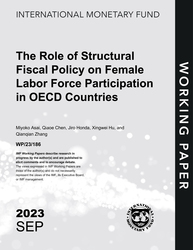
The Role of Structural Fiscal Policy on Female Labor Force Participation in OECD Countries
The Role of Structural Fiscal Policy on Female Labor Force Participation in OECD Countries
READ MORE...
Volume/Issue:
Volume 2023
Issue 186
Publication date: September 2023
ISBN: 9798400254956
$20.00
Add to Cart by clicking price of the language and format you'd like to purchase
Available Languages and Formats
| English |
Prices in red indicate formats that are not yet available but are forthcoming.
Topics covered in this book
This title contains information about the following subjects.
Click on a subject if you would like to see other titles with the same subjects.
Labor , Economics- Macroeconomics , Public Finance , Economics / General , Gender Studies , Fiscal Policy , Gender , Labor Force , OECD , panel unit root , panel vector error-correction model , robustness test , panel VECM result , female LFPR , age group , regression analysis , positive correlation , standard deviation , Women , Active labor market policies , Gender diversity , Unemployment benefits , Global
Summary
This paper examines the role of structural fiscal policies to promote female labor force participation and reduce gender gaps in labor markets in 26 OECD countries from 2000 to 2019. As both female labor force participation and many explanatory/control variables clearly exhibit non-stationarity (potentially leading to spurious regression results), we employ a panel vector error-correction model, in contrast with most previous empirical studies on this matter. Our analyses confirm statistically significant positive impacts of government spending on (1) early childcare and education, (2) active labor market programs, and (3) unemployment benefits, all of which would help encourage women to enter the labor force, while (4) an increase in relative tax rate on second earner could have negative impact on female labor force participation.
Copyright © 2010 - 2025
Powered by:
AIDC



